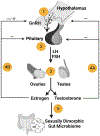Sex, puberty, and the gut microbiome
- PMID: 36445259
- PMCID: PMC9847487
- DOI: 10.1530/REP-22-0303
Sex, puberty, and the gut microbiome
Abstract
In brief: Sex differences in the gut microbiome may impact multiple aspects of human health and disease. In this study, we review the evidence for microbial sex differences in puberty and adulthood and discuss potential mechanisms driving differentiation of the sex-specific gut microbiome.
Abstract: In humans, the gut microbiome is strongly implicated in numerous sex-specific physiological processes and diseases. Given this, it is important to understand how sex differentiation of the gut microbiome occurs and how these differences contribute to host health and disease. While it is commonly believed that the gut microbiome stabilizes after 3 years of age, our review of the literature found considerable evidence that the gut microbiome continues to mature during and after puberty in a sex-dependent manner. We also review the intriguing, though sparse, literature on potential mechanisms by which host sex may influence the gut microbiome, and vice versa, via sex steroids, bile acids, and the immune system. We conclude that the evidence for the existence of a sex-specific gut microbiome is strong but that there is a dearth of research on how host-microbe interactions lead to this differentiation. Finally, we discuss the types of future studies needed to understand the processes driving the maturation of sex-specific microbial communities and the interplay between gut microbiota, host sex, and human health.
Conflict of interest statement
Figures



Similar articles
-
Genetic hypogonadal mouse model reveals niche-specific influence of reproductive axis and sex on intestinal microbial communities.Biol Sex Differ. 2023 Nov 6;14(1):79. doi: 10.1186/s13293-023-00564-1. Biol Sex Differ. 2023. PMID: 37932822 Free PMC article.
-
Systematic assessment of secondary bile acid metabolism in gut microbes reveals distinct metabolic capabilities in inflammatory bowel disease.Microbiome. 2019 May 15;7(1):75. doi: 10.1186/s40168-019-0689-3. Microbiome. 2019. PMID: 31092280 Free PMC article.
-
Precocious puberty and microbiota: The role of the sex hormone-gut microbiome axis.Front Endocrinol (Lausanne). 2022 Oct 21;13:1000919. doi: 10.3389/fendo.2022.1000919. eCollection 2022. Front Endocrinol (Lausanne). 2022. PMID: 36339428 Free PMC article. Review.
-
Genetic hypogonadal (Gnrh1hpg) mouse model uncovers influence of reproductive axis on maturation of the gut microbiome during puberty.bioRxiv [Preprint]. 2024 Jul 2:2024.07.01.601610. doi: 10.1101/2024.07.01.601610. bioRxiv. 2024. PMID: 39005422 Free PMC article. Preprint.
-
Connecting the immune system, systemic chronic inflammation and the gut microbiome: The role of sex.J Autoimmun. 2018 Aug;92:12-34. doi: 10.1016/j.jaut.2018.05.008. Epub 2018 Jun 1. J Autoimmun. 2018. PMID: 29861127 Review.
Cited by
-
Different gut microbial types were found in captive striped hamsters.PeerJ. 2023 Nov 6;11:e16365. doi: 10.7717/peerj.16365. eCollection 2023. PeerJ. 2023. PMID: 37953783 Free PMC article.
-
Gender-affirming hormonal therapy induces a gender-concordant fecal metagenome transition in transgender individuals.BMC Med. 2024 Sep 2;22(1):346. doi: 10.1186/s12916-024-03548-z. BMC Med. 2024. PMID: 39218875 Free PMC article.
-
Genetic strategies for sex-biased persistence of gut microbes across human life.Nat Commun. 2023 Jul 14;14(1):4220. doi: 10.1038/s41467-023-39931-2. Nat Commun. 2023. PMID: 37452041 Free PMC article.
-
Enduring sex-dependent implications of pubertal stress on the gut-brain axis and mental health.Front Behav Neurosci. 2024 Jan 11;17:1285475. doi: 10.3389/fnbeh.2023.1285475. eCollection 2023. Front Behav Neurosci. 2024. PMID: 38274549 Free PMC article. Review.
-
The importance of the gut microbiome and its signals for a healthy nervous system and the multifaceted mechanisms of neuropsychiatric disorders.Front Neurosci. 2024 Jan 5;17:1302957. doi: 10.3389/fnins.2023.1302957. eCollection 2023. Front Neurosci. 2024. PMID: 38249593 Free PMC article. Review.
References
-
- Abreu Maria T. 2010. ‘Toll-like receptor signalling in the intestinal epithelium: how bacterial recognition shapes intestinal function’, Nature Reviews Immunology, 10: 131–44. - PubMed
-
- Adlercreutz H, Pulkkinen MO, Hämäläinen EK, and Korpela JT. 1984. ‘Studies on the role of intestinal bacteria in metabolism of synthetic and natural steroid hormones’, J Steroid Biochem, 20: 217–29. - PubMed

